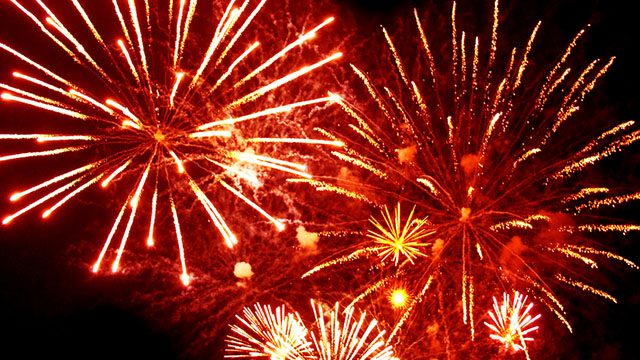SUMMARY
This is AI generated summarization, which may have errors. For context, always refer to the full article.

MANILA, Philippines – A number of cities in Metro Manila were “severely polluted” at the start of 2017, according to an initial report of the Department of Environment and Natural Resources (DENR).
As the new year kicked off, the DENR monitored the concentration of micro particle matter PM2.5 – as a result of the use of firecrackers and fireworks – from 6 air quality monitoring stations across the metro.
The DENR said PM2.5, fine particles found in smoke and haze, were a major pollutant during the early hours of Sunday, January 1.
PM2.5, if inhaled, can cause serious health problems as it travels “deeply into a person’s respiratory tract.”
“Experts have advised that particles in PM2.5 are able to travel deeply into a person’s respiratory tract and can cause short-term health effects and worsen medical conditions of people with asthma or heart disease,” Jacqueline Caancan, assistant director and officer-in-charge at the DENR’s Environmental Management Bureau (EMB), said in a statement on Wednesday, January 4.
Initial reports showed that, on Sunday, the 6 stations registered higher levels of PM2.5 compared to the early hours of 2016:
| PM2.5 |
|||
| STATION | TIME | JAN 1, 2016 | JAN 1, 2017 |
| Ateneo de Manila University, Quezon City | 2 am | 184 ug/Ncm | 369 ug/Ncm |
| Muntinlupa | 12 am | 110 ug/Ncm | 175 ug/Ncm |
| NAMRIA, Taguig | 1 am | 117 ug/Ncm | 148 ug/Ncm |
| De La Salle University, Taft, Manila | 12 am | 385 ug/Ncm | 448 ug/Ncm |
| Parañaque | 12 am | 307 ug/Ncm | 433 ug/Ncm |
| Valenzuela | 12 am | 237 ug/Ncm | 285 ug/Ncm |
Data from the DENR
The DENR said the healthy guideline values for PM2.5 is 50 ug/Ncm (micrograms per normal cubic meter of air) for 24-hour averaging, and 25 ug/Ncm annually.
Generally, these stations register lower values for PM2.5 on regular days.
For instance, the DENR said that in April 2015, the air quality monitoring station at DLSU registered 7-182 ug/Ncm, while the ones in Parañaque and Muntinlupa registered 6-18 ug/Ncm and 8-42 ug/Ncm, respectively.
During the early hours of 2017, however, the PM2.5 levels in these cities were considered “extremely dangerous” already, and the DENR pointed out that with that kind of air pollution, it was no longer deemed safe to go outside without wearing a face mask.
Jean Rosete, chief of the DENR’s Air Quality Management Section, said it is considered hazardous when PM2.5 is already twice the standard value of 50 ug/Ncm.
She pointed out, however, that the episodic air pollution in these cities went back to normal around 4 to 5 hours after it peaked at midnight of January 1.
“Makikita mo agad effect ng paputok, [pero] bababa agad. When it comes to air pollution itself, episodic lang because of the New Year’s celebration,” Rosete said in a press conference on Wednesday.
(You will immediately see the effects of firecrackers, but it will also go back to normal immediately after. When it comes to air pollution itself, it’s only episodic because of the New Year’s celebration.)
Environment Undersecretary Arturo Valdez also noted that the rain at the start of 2016 helped lessen the concentration of air pollutants back then.
“Under normal conditions, considering the reduced volume of sales [of firecrackers this year], the air pollution would have been higher last year had it not rained then,” he explained in a mix of English and Filipino.
Policy making
Valdez said they will recommend the initial findings of their monitoring to the Department of the Interior and Local Government so that the agency can come up with policies concerning the effects of firecrackers and fireworks on the country’s air pollution situation.
Rosete agreed: “It’s good to show this data to stakeholders about the effects of firecrackers, so local government units and other stakeholders can use this as basis on whether to ban, or what should be done with firecrackers during New Year’s Eve.”
Valdez said the DENR is “fully supportive” of the health department’s efforts to ban all fireworks and firecrackers during New Year’s celebration, especially since the quality of air really goes down after the festivities.
But the proposed executive order (EO) that would limit the use and possession of firecrackers or pyrotechnic devices in the country has been put on hold since President Rodrigo Duterte is still weighing its impact on the fireworks industry.
The proposed EO wants to achieve Davao City’s injury-free status after it prohibited the manufacture, sale, distribution, possession, or use of firecrackers or pyrotechnic devices in the city since 2002. – Rappler.com
Add a comment
How does this make you feel?





There are no comments yet. Add your comment to start the conversation.